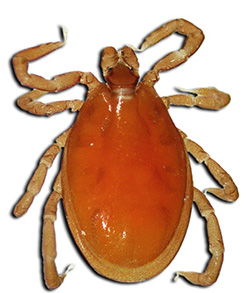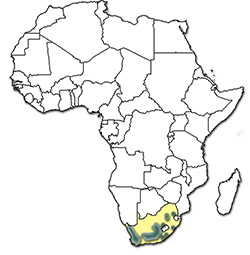Ixodes spp.
Ixodes rubicundus - Karoo paralysis tick
he common name of this tick is derived from the fact that it occurs in the Karoo in South Africa and causes paralysis in sheep. The female ticks produce a toxin that causes paralysis particularly in sheep and goats, but young calves and antelopes may also be affected. Peak numbers of adult ticks are present within 4 weeks of activity having commenced after the start of the first cold spell in late summer or autumn. A few cases of paralysis may be seen in February or March reaching a peak in April or May and are associated with a drop in environmental temperature and with moist conditions. The number of female ticks per kg of host mass is important in the causation of paralysis. Initially a paralysis of the legs is noted and this may progress until paralysis of the respiratory system and death supervene. If the ticks are removed timeously the clinical signs are reversed within a few hours.

Ixodes rubicundus |

Distribution of Ixodes rubicundus |
Adults feed on sheep, goats, caracals (Caracal caracal), and mountain reedbuck (Redunca fulvorufula). Immatures are found on rock elephant shrews (Elephantulus myurus), red rock rabbits (Pronolagus rupestris) and caracals.
Females are present in the wool-line on the limbs and belly of sheep. Males rarely attach to host animals but are frequently found attached to females. Mating can take place off the host and because many males probably do not attach to the host there are always more females than males on a host.
In South Africa, I. rubicundus occurs in the Karoo, southern Free State and small foci near the towns of Bronkhorstspruit, Belfast and Heidelberg in Gauteng and Mpumalanga Provinces. The presence of hilly or mountainous veld and of the wild olive tree (Olea africana), the shrub “besembos” (Rhus erosa), and the gras “suurpol” (Merxmeullera disticha) all support the existence of the tick as do the presence of rock elephant shrews and red rock rabbits. The ticks also prefer the southern slopes of the hills that are cooler than the northern slopes. This is a three-host tick and its life cycle takes two years to complete. Adults are most abundant on sheep and on antelopes during autumn to spring of one year, during the following year larvae are most abundant on rock elephant shrews and on red rock rabbits during late summer to winter and nymphs during winter to spring. Adult ticks appear on the vegetation and on host animals earlier in the year in the south of South Africa than in the north.
